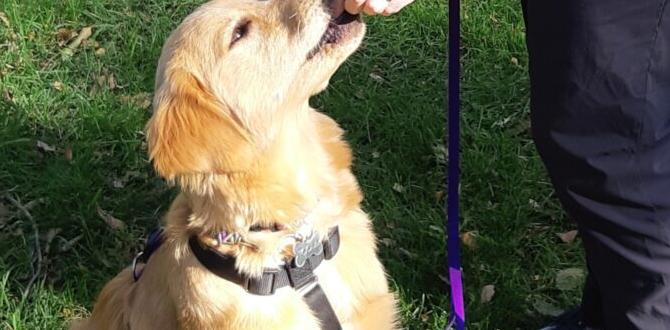Dogs communicate in many ways. Ever wondered what your dog’s behavior means? Dogs often tell us how they feel with their actions. Understanding dog behavior signs is important. This article shares advice on how to read these signs. Let’s explore how you can better understand your furry friend!
Key Takeaways
- Recognize common dog behavior signs and their meanings.
- Learn how to respond to your dog’s actions.
- Use this dog behavior signs advice daily.
- Improve your bond with your pet using these tips.
- Identify when your dog may need help or comfort.
Understanding Dog Body Language
Dogs use their bodies to talk to us. A wagging tail, for example, usually means they’re happy. But what about their other actions? Sometimes, a dog might crouch or tuck its tail. This could mean they’re scared. Knowing these signs helps us care for them better. Watching your dog’s ears, eyes, and tail can teach you a lot. Understanding these cues is important for keeping them happy and safe.
- Wagging tail often means happiness.
- Stiff body might signal discomfort.
- Barking can mean excitement or alert.
- Lip licking might show anxiety.
- Avoiding eye contact can show submission.
- Pawing could mean they want attention.
- Tucked tail often indicates fear.
Learning dog body language takes time. Each dog is different. Spend time observing your dog. This will help you recognize their unique signals. The more you know, the better you’ll understand their needs. Dogs are always communicating. It’s up to us to listen and respond.
Fun Fact or Stats : Dogs have been companions to humans for over 15,000 years!
Why Do Dogs Wag Their Tails?
Have you ever seen a dog wag its tail? Most people think it means the dog is happy. This is usually true. But sometimes, a wagging tail can mean other things. The speed and direction of the wag can tell you more. Fast wags often mean excitement. Slowly wagging might mean they are unsure. Dogs even use different tail wags with other dogs. Next time you see a wagging tail, look closer. You might discover more than you expected!
What Does a Dog’s Bark Mean?
Dogs bark to express many feelings. Have you noticed different types of barks? Some barks are loud and frequent, while others are soft and short. A loud, repeated bark might mean they see something interesting. A soft bark can be a friendly greeting. Some dogs bark when they feel lonely or scared. Understanding the different barks helps you know what your dog wants. Next time your dog barks, listen carefully. You might just understand what they’re trying to say!
How to Tell if Your Dog is Anxious
Does your dog seem uneasy at times? Dogs show anxiety in various ways. Look for signs like pacing, whining, or hiding. Sometimes, anxious dogs lick their lips or yawn a lot. Changes in their routine can cause anxiety too. To ease their stress, try to identify the trigger. Comfort them with their favorite toy or blanket. If anxiety persists, consider seeking advice from a vet. Observing your dog closely helps you provide the support they need.
Reading Dog Facial Expressions
Dog facial expressions are fascinating. Have you seen your dog raise its eyebrows? Dogs use their faces to communicate feelings. Their eyes, ears, and mouths show important cues. Wide, staring eyes might mean they’re scared or surprised. A relaxed, open mouth can indicate calmness. Dogs also lift their ears when alert or curious. Paying attention to these expressions helps you understand your dog better. Observing their face closely can reveal their mood.
- Raised eyebrows show curiosity.
- Soft, blinking eyes indicate trust.
- Alert ears suggest interest.
- Yawning can signal stress.
- Bared teeth might mean aggression.
- Relaxed mouth shows contentment.
- Drooping ears signal sadness.
Interpreting dog facial expressions takes practice. Spend time observing your dog in different settings. This helps you become skilled at reading their emotions. Dogs have unique personalities. Understanding their facial cues makes your bond stronger. When you know what your dog is expressing, you can respond appropriately.
Fun Fact or Stats : Dogs have over 20 different facial expressions!
What Do a Dog’s Eyes Tell Us?
Have you ever looked into a dog’s eyes? They can tell us a lot. Soft, blinking eyes usually mean your dog feels safe. Wide eyes can indicate surprise or fear. Dogs may also squint to show they’re relaxed. Their eyes can communicate trust or caution. By observing their eyes, you get a glimpse of their feelings. Try looking into your dog’s eyes next time. You might learn something new about their emotions!
Understanding Dog Ears Movement
Dog ears are fascinating communication tools. Have you seen them perk up suddenly? When dogs hear something interesting, their ears stand erect. Drooping ears can mean they’re relaxed or disappointed. Dogs with floppy ears may have different ear cues. Watching how their ears move can help you understand their feelings. Ears are like radar dishes for dogs. They help them gather information and express emotions. Pay attention to your dog’s ears. They might surprise you with what they tell!
How Dogs Use Their Mouths to Communicate
Dogs communicate a lot through their mouths. Ever notice your dog yawning or licking its lips? These actions can show different emotions. Yawning might mean they’re stressed or tired. Licking lips could indicate anxiety. A relaxed, open mouth often means they’re happy. Dogs may bare their teeth to show aggression or fear. By watching their mouths, you can read their mood better. Understanding these cues helps you respond with care and kindness.
Interpreting Dog Vocalizations
Dogs are known for their unique sounds. Have you heard your dog make different noises? Besides barking, dogs whine, growl, and howl. Each sound carries a different message. Whining can mean they want attention or feel unwell. Growling often signals discomfort or a threat. Howling might mean they’re trying to communicate with others far away. Learning these sounds helps you understand your dog better. Pay attention to their vocalizations. They might be telling you something important.
- Barking signals excitement or alert.
- Whining shows need or discomfort.
- Growling indicates threat or fear.
- Howling communicates with distant others.
- Sighing can mean contentment or boredom.
- Grunting may signal relaxation.
- Huffing shows curiosity or warning.
Each dog is unique in their vocalizations. Some may bark more than others. Spend time listening to your dog’s sounds. This helps you learn their language. Recognizing these sounds builds a stronger connection. When you understand their vocal cues, you can respond to their needs timely.
Fun Fact or Stats : Ancient cultures believed dogs could communicate with spirits through howling!
Why Does My Dog Whine?
Have you ever wondered why dogs whine? Whining is one way they share their feelings. When dogs whine, they might want something. It could be food, water, or a walk. Sometimes, they whine because they feel lonely or scared. Whining can also mean they’re in pain. Listening to the pitch and length of the whine can help you understand. Next time your dog whines, think about what they might be asking for.
Understanding Dog Growls
Have you heard your dog growl? Growling can seem scary. But it often means your dog is warning you. They might feel threatened, upset, or protective. Growling is a way to say “stay back.” Sometimes, playful dogs growl during roughhousing. Understanding the context is key. Listen to the tone and situation. Growling doesn’t always mean aggression. It’s their way of communicating boundaries. Understanding this helps prevent misunderstandings.
Decoding Dog Howls
Have you ever heard your dog howl? Dogs howl for various reasons. In the wild, howling helps them communicate with their pack. Domesticated dogs might howl to mimic this. Howling can also mean they hear something interesting, like a siren. Sometimes, dogs howl when they’re lonely. If you hear your dog howling, consider the situation. They might be trying to reach out or call for attention. Understanding their howls can help you connect with them better.
Using Dog Behavior Signs Advice
Understanding dog behavior signs advice is crucial for every dog owner. This advice helps you respond to your dog’s needs. By recognizing their actions, you ensure their well-being. Pay attention to their body language and sounds. This builds a strong bond and trust with your pet. Knowing when they need comfort or play becomes easier. Use this advice daily to improve your relationship. Regular observation leads to better understanding.
- Observe your dog’s daily actions.
- Respond calmly to their signals.
- Provide comfort during stress.
- Engage in play to boost happiness.
- Consult a vet if behavior changes.
- Build trust through consistent care.
- Learn from your dog’s unique cues.
Using dog behavior signs advice takes practice. Spend time understanding your pet’s habits. This strengthens your connection and ensures a happy pet. Remember, dogs communicate constantly. It’s our job as owners to listen and respond. By doing so, you create a harmonious environment for your furry friend.
Fun Fact or Stats : Dogs can understand up to 250 words and gestures!
Why Understanding Dog Behavior Matters
Have you ever thought about why understanding dog behavior is important? It helps you meet their needs promptly. Knowing their signals prevents misunderstandings. You create a safe space for them. Recognizing stress signs allows timely comfort. It also helps you identify health issues early. Understanding your dog strengthens your bond. Your pet feels loved and cared for. This mutual understanding makes you a better pet owner.
How to Improve Dog-Owner Communication
Have you wondered how to communicate better with your dog? Start by observing their actions closely. Make eye contact and use gentle words. Practice consistent commands for training. Be patient and attentive to their signals. Reward positive behavior with treats or praise. Spend quality time playing and bonding. This strengthens communication and trust. A strong bond leads to a happy and healthy pet-owner relationship.
What if My Dog’s Behavior Changes?
Have you noticed changes in your dog’s behavior? Changes can mean many things. They might feel unwell or stressed. New environments or family members can affect them. If changes persist, seek professional advice. A vet can check for health issues. Sudden changes may need training or adjustment. Paying attention to these changes is crucial. It ensures your pet’s comfort and happiness. Early intervention prevents problems from growing.
Conclusion
Understanding dog behavior signs is essential for a happy pet-owner bond. This advice helps you respond effectively to your dog’s needs. Observe their actions, listen to their sounds, and watch their expressions. By doing so, you create a safe and loving environment. Remember, your dog communicates in unique ways. Pay attention, respond with care, and build a joyful relationship.
FAQs
Question: Why does my dog bark so much?
Answer: Dogs bark for many reasons. It could be excitement, alertness, or attention-seeking. Sometimes, they bark to communicate with other dogs. Understanding their barking helps you know their needs. Use dog behavior signs advice to identify patterns. Once you know the cause, you can address it effectively.
Question: How can I calm my anxious dog?
Answer: To calm an anxious dog, identify the trigger first. Provide a comforting environment. Use soothing words and gentle petting. A favorite toy or blanket can help. If anxiety continues, seek professional advice. Understanding dog behavior signs is useful here. It helps you provide timely comfort and care.
Question: What does it mean if my dog avoids eye contact?
Answer: Avoiding eye contact can mean submission or anxiety. Dogs might feel shy or unsure. In some cases, it’s a sign of respect. Use this dog behavior signs advice to understand context. Offer reassurance and observe any other signs. This helps you know how to respond appropriately.
Question: Why does my dog howl at sirens?
Answer: Dogs howl at sirens due to their natural instincts. Sirens mimic the sound of a howling pack. Your dog might join in, thinking it’s communicating with others. This behavior is normal for many dogs. Understanding dog behavior signs helps you know when it’s a concern.
Question: How do I know if my dog is happy?
Answer: A happy dog shows several signs. Look for a wagging tail, relaxed posture, and soft eyes. They might play actively or cuddle with you. Use dog behavior signs advice to observe these cues. Each dog is unique, so learn their specific happiness indicators.
Question: What should I do if my dog growls at me?
Answer: If your dog growls, remain calm. Avoid sudden movements. Try to understand the reason behind it. They might feel scared or protective. Give them space and reassurance. Dog behavior signs advice can guide you in responding calmly.
Meet Elyse Colburn, the devoted canine companion and storyteller behind the enchanting world of “Tales, Tails, and Adventures Unleashed.” A passionate dog enthusiast with a heart full of paw prints, Elyse Colburn shares heartwarming tales and insightful adventures, celebrating the joy, loyalty, and endless antics that make every dog a true hero. Join Elyse Colburn on this tail-wagging journey, where every post is a love letter to our four-legged friends.








